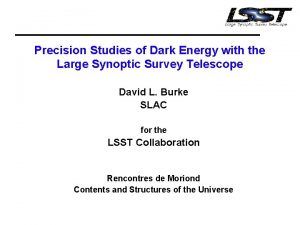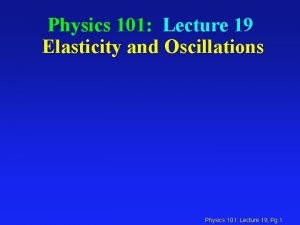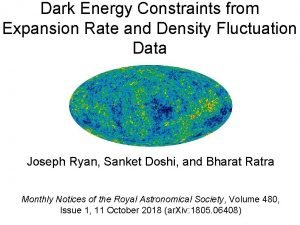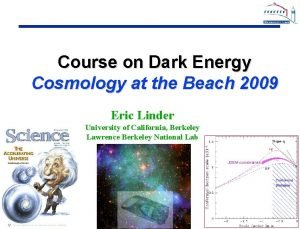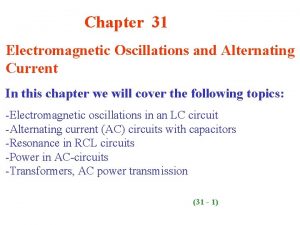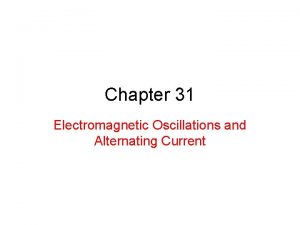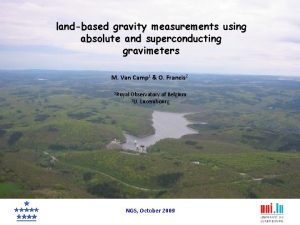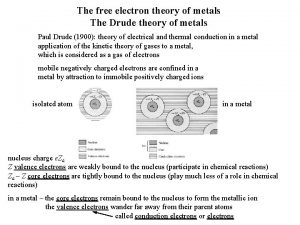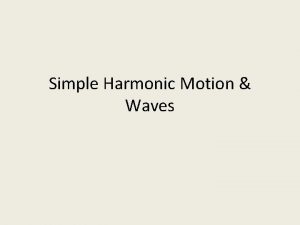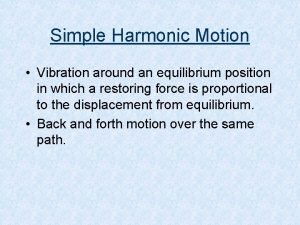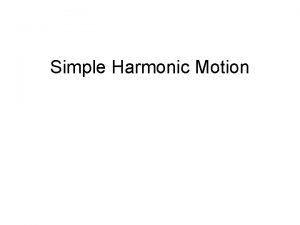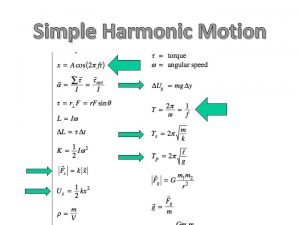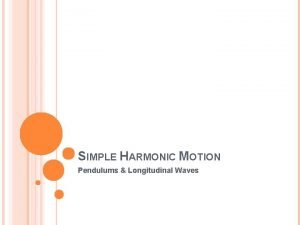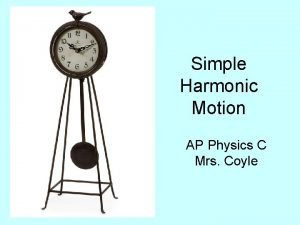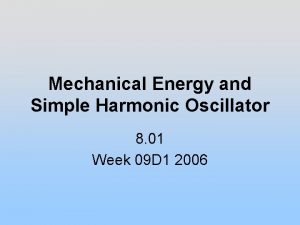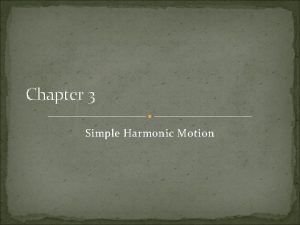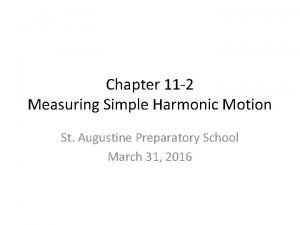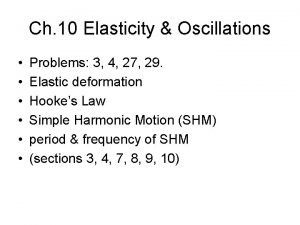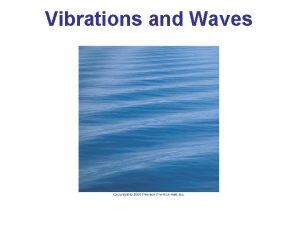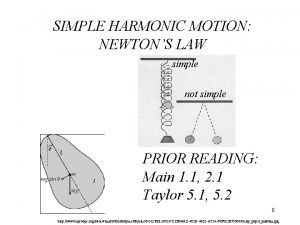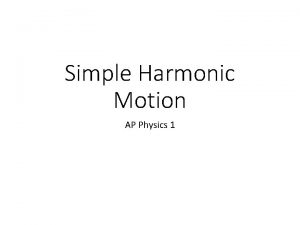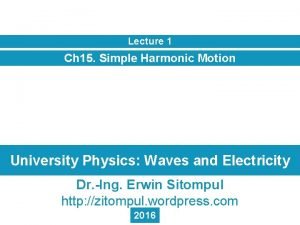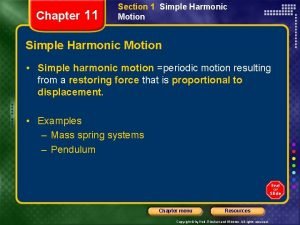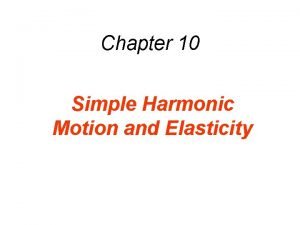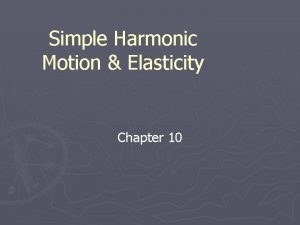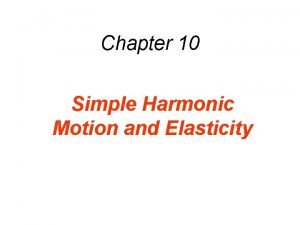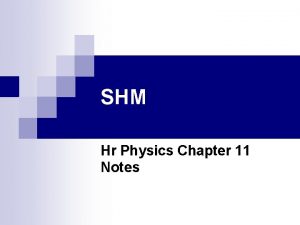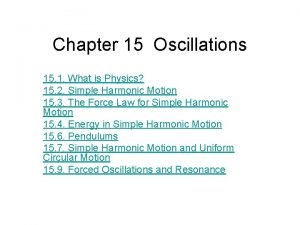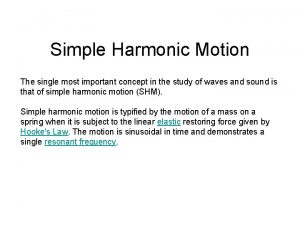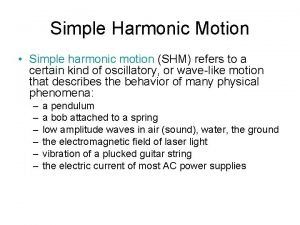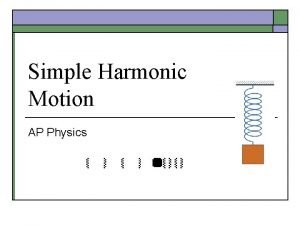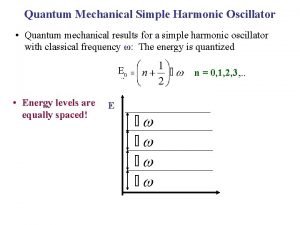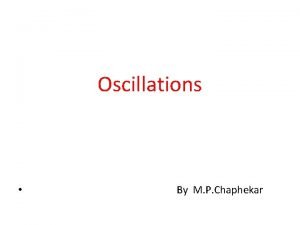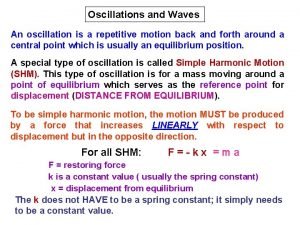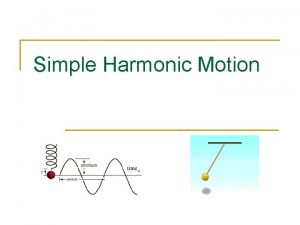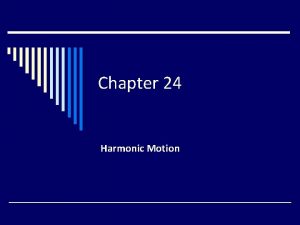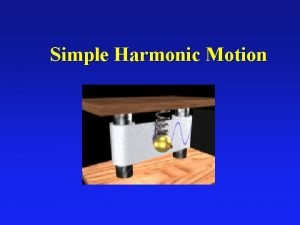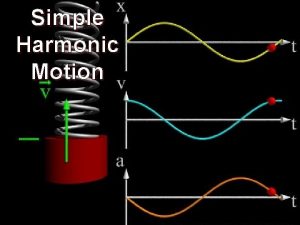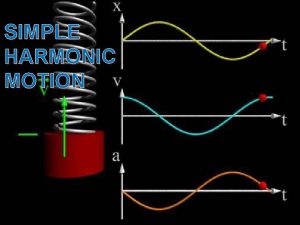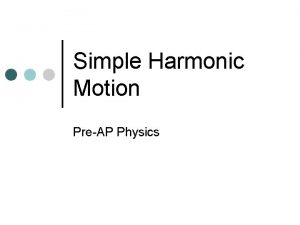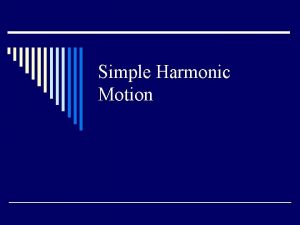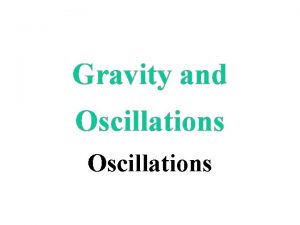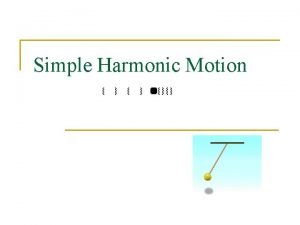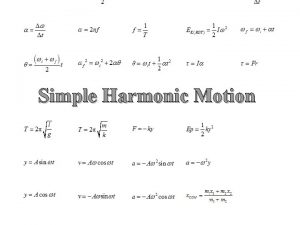Oscillations Simple Harmonic Motion Simple Harmonic Motion Simple


















































- Slides: 50

Oscillations Simple Harmonic Motion

Simple Harmonic Motion Simple harmonic motion is the repetitive motion of an oscillating object (simple harmonic oscillator). Example: A spring mass system. Like circular motion, simple harmonic motion has a regular period and frequency. In fact, simple harmonic motion and circular motion are linked both mathematically and graphically.

Equilibrium The spring mass system shown below is at equilibrium ( x = 0 ). Equilibrium for a spring is its natural rest position. This spring can either be stretched or compressed, displacing the mass from its current equilibrium position. +F 0 To stretch the spring a force, F , must be applied in the +x direction. This new unbalanced force will displace the mass from equilibrium.

A force is applied As the mass is displaced the spring generates an increasing force of it own. +F 0

A force is applied −FS 0 As the mass is displaced the spring generates an increasing force of it own. +F

A force is applied −FS 0 As the mass is displaced the spring generates an increasing force of it own. +F

A force is applied As the mass is displaced the spring generates an increasing force of it own. −FS 0 +F

A force is applied As the mass is displaced the spring generates an increasing force of it own. This force is known as a restoring force, as it acts to restore the spring to its original equilibrium position. −FS 0 +F

Amplitude When the applied force, F , and the restoring force, FS , are equal and opposite the oscillator is stationary. The oscillator has reached maximum displacement, xmax. Maximum displacement is known as the amplitude, A. This is equal to the radius, R , of a circle matching the springs displacement. −FS 0 +F +A = xmax

The Oscillator is Released When the applied force, F, is removed, the restoring force moves the mass left. x −FS 0 x +F +A

The Oscillator is Released When the applied force, F, is removed, the restoring force moves the mass left. x −FS 0 x +A

The Oscillator is Released When the applied force, F, is removed, the restoring force moves the mass left. x −FS 0 x +A

The Oscillator is Released When the applied force, F, is removed, the restoring force moves the mass left. x −FS 0 x +A

The Oscillator is Released When the applied force, F, is removed, the restoring force moves the mass left. x −FS 0 x +A

The Oscillator is Released R = A = xmax When the applied force, F, is removed, the restoring force moves the mass left. ω Δθ x The radius of the circle is equal to the maximum displacement (amplitude) R = A = xmax The radius, R = A , and displacement, x , are two of the sides of a right triangle. While the mass moved to the left the corresponding point on the circle moved with an angular velocity, ω , through an angle, Δθ. −FS 0 x +A

Conclusion R = A = xmax ω Δθ x An oscillator’s displacement equals the x-component of the radius of another object that is in uniform circular motion with the same amplitude (R = A = xmax). Cosine solves for x. In uniform circular motion Therefore, −FS 0 x +A

Conclusion Period and frequency are related to angular velocity. R = A = xmax ω Which rearrange to Δθ x These can be substituted into the previous equation −FS 0 x +A

Putting all together The motion described by this equation looks like… x(t) FS x(t) −A 0 +A

Putting all together The motion described by this equation looks like… ω Δθ x(t) FS x(t) −A 0 +A

Putting all together ω Δθ x(t) FS x(t) −A 0 +A The motion described by this equation looks like…

Putting all together ω Δθ x(t) FS x(t) −A 0 +A The motion described by this equation looks like…

Putting all together ω Δθ x(t) −A 0 +A The motion described by this equation looks like…

Putting all together ω Δθ x(t) FS x(t) −A 0 +A The motion described by this equation looks like…

Putting all together ω Δθ x(t) FS x(t) −A 0 +A The motion described by this equation looks like…

Putting all together ω Δθ x(t) FS x(t) −A 0 +A The motion described by this equation looks like…

Putting all together ω Δθ x(t) FS x(t) −A 0 +A The motion described by this equation looks like…

Putting all together ω Δθ x(t) FS x(t) −A 0 +A The motion described by this equation looks like…

Putting all together ω Δθ x(t) FS x(t) −A 0 +A The motion described by this equation looks like…

Putting all together ω Δθ x(t) FS x(t) −A 0 +A The motion described by this equation looks like…

Putting all together ω Δθ x(t) −A 0 +A The motion described by this equation looks like…

Putting all together ω Δθ x(t) FS x(t) −A 0 +A The motion described by this equation looks like…

Putting all together ω Δθ x(t) FS x(t) −A 0 +A The motion described by this equation looks like…

Putting all together ω Δθ x(t) FS x(t) −A 0 +A The motion described by this equation looks like…

Putting all together ω Δθ x(t) FS x(t) −A 0 +A The motion described by this equation looks like…

Graphing Oscillations +A 0 x(t) −A FS x(t) −A 0 +A π 2π

Putting all together +A ω Δθ x(t) 0 −A FS x(t) −A 0 +A π 2π

Putting all together ω Δθ +A 0 x(t) −A 0 +A π 2π

Putting all together ω Δθ +A 0 x(t) −A FS x(t) −A 0 +A π 2π

Putting all together ω Δθ +A 0 x(t) −A FS x(t) −A 0 +A π 2π

Putting all together ω Δθ +A 0 x(t) −A FS x(t) −A 0 +A π 2π

Putting all together ω Δθ +A 0 x(t) −A 0 +A π 2π

Putting all together ω Δθ x(t) +A 0 −A FS x(t) −A 0 +A π 2π

Putting all together ω Δθ +A 0 x(t) −A FS x(t) −A 0 +A π 2π

Analyzing Oscillation Graphs: Amplitude is the largest displacement and it can be easily read on the graph.

Analyzing Oscillation Graphs: Period is the time of one cycle (1 revolution). One cycle is one complete wave form. This wave form extends from 3 seconds to 15 s. The time of this wave form is 15 − 3 = 12 s

Analyzing Oscillation Graphs: Frequency is the inverse of period.

Analyzing Oscillation Graphs: Displacement can be solved using the displacement equation and substituting the values determined in the previous slides. Substitute the given time to determine the matching displacement.

Analyzing Oscillation Graphs: Maximum Speed Maximum speed can be found using the equation for speed in uniform circular motion. Set the radius equal to amplitude.

Analyzing Oscillation Graphs: Qualitatively When is the object moving to the right at maximum speed? This occurs at equilibrium (x = 0) and when object is moving toward a greater displacement value: 9 and 21 seconds When is the object moving to the left at maximum speed? This occurs at equilibrium (x = 0) and when object is moving toward a lesser displacement value: 3 and 15 seconds When is the object instantaneously at rest? This occurs at maximum displacement: 0, 6, 12, 18, and 24 seconds.

Circular Motion R Δθ x(t) y(t) ω Oscillation is only concerned with the component of the circular motion equation that is parallel to the oscillation. If a spring is oscillating horizontally If a spring is oscillating vertically Circular motion involves both equations simultaneously. Amplitude is equal radius R , and Δθ = ω t.
 Shm equations
Shm equations Tension wave
Tension wave Baryon acoustic oscillations
Baryon acoustic oscillations Elasticity and oscillations
Elasticity and oscillations Small amplitude rhythmic oscillations
Small amplitude rhythmic oscillations Universe expanding faster should
Universe expanding faster should Baryon acoustic oscillations
Baryon acoustic oscillations Baryon acoustic oscillations
Baryon acoustic oscillations Electromagnetic oscillations and alternating current
Electromagnetic oscillations and alternating current Electromagnetic oscillations and alternating current
Electromagnetic oscillations and alternating current Baryonic acoustic oscillations
Baryonic acoustic oscillations Tanya leise amherst
Tanya leise amherst Slow oscillations
Slow oscillations Velocity resonance
Velocity resonance Drude free electron theory
Drude free electron theory Plasma oscillations
Plasma oscillations Oscillations
Oscillations Simple harmonic motion vocabulary
Simple harmonic motion vocabulary Simple harmonic motion equilibrium position
Simple harmonic motion equilibrium position Spring constant simple harmonic motion
Spring constant simple harmonic motion Reference circle simple harmonic motion
Reference circle simple harmonic motion What unit is period measured in
What unit is period measured in Harmonic equation physics
Harmonic equation physics Period of simple harmonic motion
Period of simple harmonic motion Q=qmax cos wt
Q=qmax cos wt Simple harmonic oscillator
Simple harmonic oscillator Simple harmonic motion
Simple harmonic motion The body of a 1275 kg car is supported
The body of a 1275 kg car is supported Frequency of shm
Frequency of shm Simple harmonic motion formula
Simple harmonic motion formula Simple harmonic motion formula
Simple harmonic motion formula Shm ap physics 1
Shm ap physics 1 Simple harmonic motion presentation
Simple harmonic motion presentation What is angular frequency in shm
What is angular frequency in shm Simple harmonic motion chapter 11
Simple harmonic motion chapter 11 Simple harmonic motion and elasticity
Simple harmonic motion and elasticity Simple harmonic motion and elasticity
Simple harmonic motion and elasticity Kinematics of simple harmonic motion
Kinematics of simple harmonic motion Harmonic
Harmonic A trapeze artist swings in simple harmonic
A trapeze artist swings in simple harmonic K=mω^2
K=mω^2 What is simple harmonic motion
What is simple harmonic motion Simple harmonic motion notes
Simple harmonic motion notes Oscillation of spring
Oscillation of spring Simple harmonic motion definition
Simple harmonic motion definition Definition of periodic motion
Definition of periodic motion Simple harmonic motion
Simple harmonic motion Damped oscillation
Damped oscillation Simple harmonic motion
Simple harmonic motion Simple harmonic motion lecture
Simple harmonic motion lecture Angela b. pan
Angela b. pan


